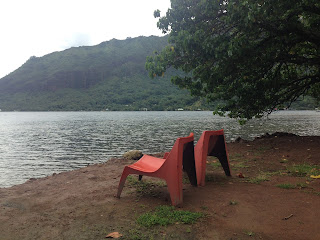
Pape’ete,
Tahiti, French Polynesia
**French
Polynesia encompasses 5 groups of islands: The Society Islands archipelago; the
Tuamotu Archipelago [see Blog about Rangiroa]; the Gambier Islands; the
Marquesas Islands [see Blog about Nuku Hiva]; and the Austral Islands.

 Tahiti, located within the Society Islands archipelago, is the largest
and most populated of the islands. Tahiti’s mountain peaks reach upwards to
7300 feet and house lush valleys, rainforests, waterfalls, and abundant flowers
and fruit.
Tahiti, located within the Society Islands archipelago, is the largest
and most populated of the islands. Tahiti’s mountain peaks reach upwards to
7300 feet and house lush valleys, rainforests, waterfalls, and abundant flowers
and fruit. The bustling port capital, Pape’ete, resembles a large metropolitan city rather than the romantic swaying palm trees and grass huts I was expecting.
The bustling port capital, Pape’ete, resembles a large metropolitan city rather than the romantic swaying palm trees and grass huts I was expecting.
In contrast to the swaying,
smooth, gentle wave-like hula moves of Hawaii, the Tahitian dance and music pulses quickly with a fiery rhythm like a volcano. It is electric and tribal, and I saw this reflected in much of the graffiti scattered throughout the city.
The hustling
energy of the city shows up in the Central Market where locals sell traditional Tahitian crafts, flowers, fruits, fish, and everything in between. And given the French influence, the city does not lack outdoor cafes, coffee, and fresh baguettes. Although it was not the romanticized island landscape I have envisioned, this big city has its own personality and charm.
Mo’ore’a,
Tahiti
When I close my
eyes to picture the most idyllic place to live, my memories from here would
fill my heart and mind. Mo’ore’a is Pape’ete’s beautiful sister. In contrast to
the frenetic tempo of Pape’ete, Mo’ore’a’s calm demeanor reflects in her lush
green mountains rising majestically over tranquil inlets harboring sailboats.
 This heart-shaped
island formed over a million years ago from a volcano. Originally, the island’s
poetic name, Aimeo I Te Rara Varu depicted the eight majestic mountain ridges
of her landscape. A high priest’s dream in later years led to the current name,
which means “yellow lizard.” Natives of Pap’ete and Mo’ore’a each claim their
island as inspiration for the mythical Bali Hai based on the Michener novel
about the South Pacific. The jagged peaks and lush landscape complement the
beautiful white sand beaches and electric blue water.
This heart-shaped
island formed over a million years ago from a volcano. Originally, the island’s
poetic name, Aimeo I Te Rara Varu depicted the eight majestic mountain ridges
of her landscape. A high priest’s dream in later years led to the current name,
which means “yellow lizard.” Natives of Pap’ete and Mo’ore’a each claim their
island as inspiration for the mythical Bali Hai based on the Michener novel
about the South Pacific. The jagged peaks and lush landscape complement the
beautiful white sand beaches and electric blue water.
You can
circumnavigate the island via a 40-mile stretch of winding road, promising
beauty and majesty at every turn. From
every viewpoint the mountains beckon you to hike them. When you do venture into
the hills, you find some remarkable ancient landmarks, called marae, on
which ancient stone rocks shaped like pyramids contain carvings that detail the occurrences of sacrifices.
Belvedere
lookout, perched in the mountains between Cooks Bay and Opunohu Bay, offers breathtaking
views of the ocean and the majestic peaks.
 |
| Marae |
Early in the day I ventured along a local road observing chickens and dogs wandering the streets and delivery boys bringing freshly baked baguettes [it is French Polynesia ,after all] to homes by bicycle. Although no official town exists on the island, areas along the road have a few stores selling local crafts, sarongs [pareos] and fresh fruit. Noni, papaya and mango trees, overloaded with fruit, are everywhere.
 |
| Bliss |








